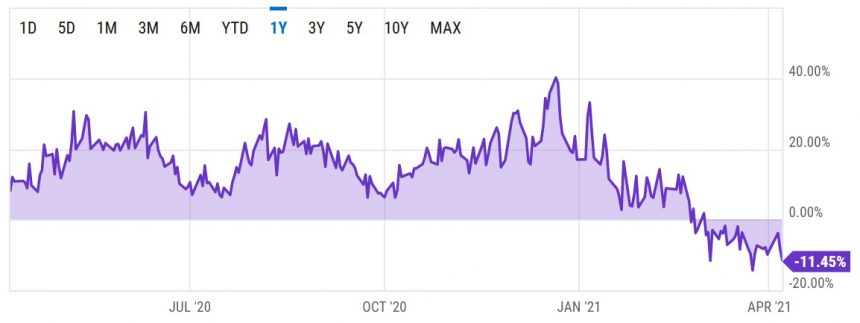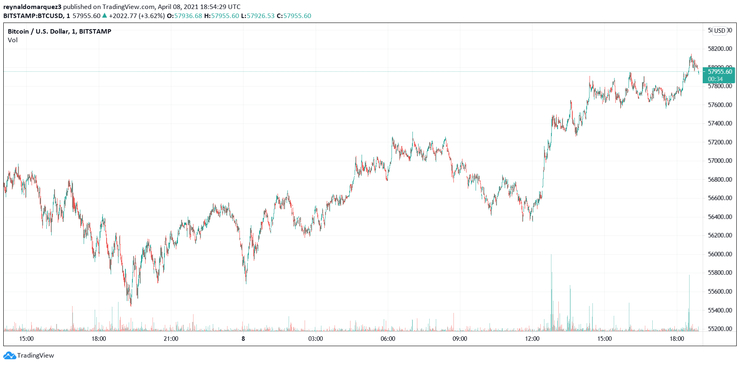How Grayscale Bitcoin Trust at a discount could change everything for BTC

After spending the entire month of March at a loss, the downtrend in Grayscale Bitcoin Trust premium has extended. At the time of publication, the premium stands at -11.45%, near its all-time low at -14%.

In contrast, the Canadian Purpose Bitcoin ETF had a nearly month-long streak at record inflow levels begging April. Comparing the data, GBTC at a discount, and the growth in the BTC ETF, there is a trend in investors favoring the latter.
Also the Canada Bitcoin ETF’s lifetime inflow streak has now reached 25 DAYS, an unprecedented feat in ETF history. This is my new $JETS. pic.twitter.com/HjB5qmcP9r
— Eric Balchunas (@EricBalchunas) April 2, 2021
Unlike other financial products, GBTC shares cannot be freely traded. They must go through a 6-month “lock-up” period. Although they give exposure to the price of BTC, stakeholders’ strategy to profit is based on the premium, as analyst Ben Lilly points out:
30% return is pretty impressive, and natural economic pressures should bring this premium down to 0%. Yet, for some reason we just haven’t seen that happen yet. That’s because of the way it operates and no other option being available.
If after 6 months, the GBTC premium is high, it can be sold for a large percentage of profits. Otherwise, losses can be just as steep.
Grayscale investors have started to express discontent. Investment firm Marlton issued a press release on April 6, to call for Grayscale to take “immediate action to address GBTC’s significant discount to net asset value” (NAV).
Marlton’s data indicates that GBTC’s premium discount represents an estimated $3.1 billion in losses to stockholders. The firm has called for a modification to the stock trading mechanism that would allow them to sell or buy shares at specific prices and at a specific time.
As Ben Lilly points out, the advent of new options to gain Bitcoin exposure in Canada appears to be hurting GBTC. Researcher Jan Wuestenfeld supports this thesis:
(GBTC) trading at a discount since the beginning of march and their Bitcoin holdings have been stagnating. It looks like with new alternatives coming to the market investors might turn to other products to get exposure to Bitcoin.
High demand for Bitcoin-based regulated financial products
The above indicates a clear demand from institutions looking to acquire exposition to Bitcoin. In parallel, the Security and Exchange Commission (SEC) is under a lot of pressure to approve a Bitcoin ETF. The Commission has received over 6 petitions to approve a Bitcoin ETF in the U.S. in under 4 months.
The discount in the GBTC suggests that investors are favoring products with better trading mechanisms. The performance of Canada’s BTC ETF could create even more pressure for the U.S. regulator.
Senior Commodity Analyst for Bloomberg, Mike McGlone, sees a major inflection point in terms of adoption. New Bitcoin-based financial products could create a new “rising tide” from institutions and individuals investors trying not to “miss out on the potential for Bitcoin”. McGlone claimed:
(…) we see rising potential for 2021 to mark a migration milestone into traditional investment portfolios. Publicly traded cryptocurrency funds’ assets, dominated by Bitcoin, have surged to almost $60 billion as of March 25 from less than $10 billion in October. Growth has been driven by both rising inflows and skyrocketing prices for the funds’ underlying holdings. A U.S. Bitcoin ETF, on the back of recent launches in Canada, would likely accelerate expansion.
BTC is trading at $57,948 and is showing moderate gains in the 24-hour chart at 3.5%. On the 7 day chart, BTC is still moving sideways.
